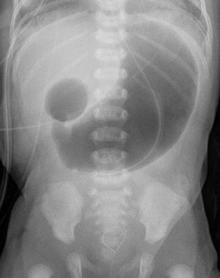Double bubble (radiology)

In
Distal gas is more often seen with midgut volvulus, duodenal stenosis and duodenal web, though this not always present. In such cases, distinguishing the diagnoses depends on clinical presentation.[4]
Follow up imaging
A fluoroscopic study known as an upper gastrointestinal series is often the next step in management in patients that are not critically ill, though if volvulus is suspected, emergent surgical intervention is mandated. If clinical findings are equivocal, caution with non water-soluble contrast is needed, as the usage of barium can impede surgical revision and lead to increased post operative complications. Non ionic water-soluble contrast should be used, as the hyperosmolar agents, if aspirated, can result in life-threatening pulmonary edema. When reflective of duodenal atresia, associations with Down syndrome and VACTERL sequence abnormalities are often seen.[5]
Mimics
Certain rare anatomic anomalies, such as congenital duodenal duplication[6] and pyloric atresia[7] can cause false positives for the sign on radiographs. Congenital pyloric atresia usually causes a single bubble on radiographs without distal gas, though an intermittent double bubble sign is occasionally seen.[8] Duodenal atresia, while typically without distal gas, has been reported with an absent double bubble, though this variant is quite rare.[9] On neonatal ultrasound, a double bubble can also be caused by a choledochal cyst, omental cyst, or enteric duplication cyst.
References
- PMID 13980384.
- PMID 1958936.
- PMID 1560073.
- ISBN 9783540715160.
- ISBN 9781139490641.
- PMID 9430213.
- S2CID 222140.
- S2CID 34229438.
- S2CID 23684551.
